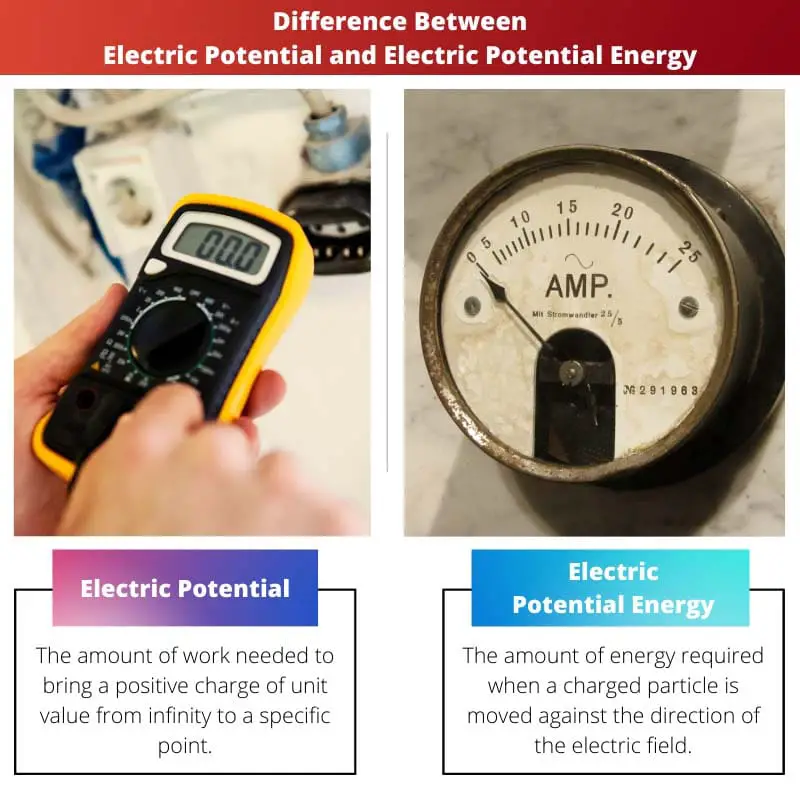In the world of physics, some terminologies are so popular and common that a layman should understand those terms. Electric potential and electric potential energy are two such terms.
Most importantly for an electrician, these two are crucial terms holding higher importance. While the former refers to the amount of work done, the latter refers to the amount of energy invested.
Therefore, the former is calculated in Volt, but the latter is calculated in Joule.
Key Takeaways
- Electric potential is the work required to move a unit charge from infinity to a specific point. In contrast, electric potential energy is required to move a charge within an electric field.
- Electric potential is a scalar quantity measured in volts, whereas electric potential energy is a scalar quantity measured in joules.
- Electric potential depends on the charge and distance from the source, while electric potential energy depends on the charge, distance, and electric field strength.
Electric Potential vs Electric Potential Energy
The difference between electric potential and electric potential energy is that, in the field of physics, an electric potential is commonly abbreviated as ‘V.’ However, on the contrary, electric potential energy is commonly symbolised by the letter ‘U’ in physics. Electric potential is called by many names, such as potential drop, electrostatic potential and electric field potential.

The amount of numeric value of work required to get one charged particle-containing plus charge from infinity to a given place is defined as electric potential. Volt is considered the SI unit for the measurement of electric potential.
The quantitative value of electric potential is the only thing that matters. As a result, the quantity is scalar.
Only one unit of positive charge is taken into account in electric potential.
The amount of energy required to drive a particle that carries a charge in the opposite direction of the field of electricity is known as electric potential energy.
Although the electric potential energy is measured in opposition to the electric field direction, it is a scalar number because it is independent of it. A set of unit charges is regarded as electric potential energy, which can be positive or negative.
Comparison Table
| Parameters of Comparison | Electric Potential | Electric Potential Energy |
|---|---|---|
| Definition | The amount of work needed to bring a positive charge of unit value from infinity to a specific point. | The amount of energy required when a charged particle is moved against the direction of the electric field. |
| Denoted by | Denoted as V | Denoted as U |
| SI Unit | SI unit is Volt | SI unit is Joule |
| Quantity type | Scalar Quantity | Scalar Quantity |
| Charges | One positive charge of unit value. | Set of unit charges. |
What is Electric Potential?
The amount of labour required to get a positive charge of unit value from infinity to a given place is defined as electric potential. In the field of physics, an electric potential is commonly symbolised by the letter ‘V.’
Volt is the international standard unit (SI) for electric potential. Electric potential does not have a direction, but it does have a magnitude.
As a result, it’s a scalar quantity. Only one positive charge of unit value is considered in electric potential.
Potential drop, electrostatic potential, and electric field potential are all terms used to describe the electric potential. Electrostatic potential or electric potential is the gradient of the electrostatic field or electric field.
The electric field is a quantity that is a vector. However, an electric potential is a scalar.

What is Electric Potential Energy?
The amount of energy required to transport a charged particle opposite to the direction of the presence of an electric field is described as electric potential energy. Electric potential energy is commonly abbreviated as ‘U’ in physics applications.
A collection of unit charges, which might be positive or negative, is taken into account in “U” or electric potential energy or, normally, potential energy.
Joule is considered as the SI unit for “U” or potential energy or the worldwide standard unit. However, the electric potential energy is quantified in terms of movement in the direction opposite to that of the field of electricity.
It is a scalar number because it is independent of the direction.
Electric potential energy perfectly describes the electric fields of time-variant systems of potential energy. There are similar terms, such as electrostatic potential energy also exists.
That term refers to the systems of time-invariant potential energy in the electric fields.

Main Differences Between Electric Potential and Electric Potential Energy
- Electric potential or potential drop is defined as the amount of work done to bring or move a positive or plus charge of numeric value 1 from infinity to a particular point. However, electric potential energy is described as the numeric value or amount of energy needed when a charged particle is moved against the direction of the electric field.
- Electric potential is denoted as ‘V’ in the world of physics. On the other hand, in the application of physics, electric potential energy is denoted as ‘U’.
- The international standard unit or SI unit of potential drop or electric potential is Volt. On the other hand, the international standard unit or SI unit of electric potential energy or “Ue” is Joule.
- Potential drop or Electric potential does not depend upon direction. However, it has magnitude only. Hence, it is a scalar quantity. On the contrary, although the electric potential energy is measured via movement against the electric field direction, it does not depend upon it, and thus, it is a scalar quantity.
- In electric potential, only one positive charge of unit value is considered. On the other hand, in electric potential energy, a set of unit charges are considered. They can be positive or negative. Conclusion

- https://agupubs.onlinelibrary.wiley.com/doi/abs/10.1029/JA085iA02p00664
- https://open.metu.edu.tr/handle/11511/16445

The comprehensive comparison table effectively highlights the differences between electric potential and electric potential energy, making it a reference point for understanding the two concepts.
Agreed, the comparison table provides a succinct overview of the disparities, making it beneficial for those seeking a quick reference.
The clear distinction between the two terms is beneficial for anyone delving into the subject. The comparison table is particularly helpful in this regard.
The inclusion of clear, relatable examples to define electric potential and electric potential energy sets a commendable standard for comprehensibility in physics concepts.
The meticulous approach to defining and distinguishing these terminologies ensures that readers of varying levels find value in this content.
Agreed, the relatability of examples enriches the understanding of these physics terminologies, making the content more approachable.
The content is presented in a clear, structured manner, making it easier for readers to grasp the differences between electric potential and electric potential energy.
Absolutely, the clarity of the content is commendable. It’s evident that this article comes from a well-informed perspective.
The explanation provided serves as the foundation for anyone wishing to understand the concept of electric potential and electric potential energy.
An insightful take on the key differences between electric potential and electric potential energy. The use of clear examples make understanding easier.
The breakdown of these physics concepts is particularly helpful for better comprehension. Hoping to see more detailed breakdowns on other topics as well.
The article adeptly explains the distinct attributes of electric potential and electric potential energy. This can serve as a valuable resource for students and enthusiasts alike.
The in-depth analysis of these concepts is noteworthy. It’s great to see comprehensive explanations that cater to a wide audience.
The clear differentiation between electric potential and electric potential energy, along with the definitions and SI units, enhances the accessibility of this content for readers.
The accessibility of the explanations makes this article a valuable resource for those aiming to understand the intricacies of electric potential and electric potential energy.
The lucid explanations and breakdowns make this content beneficial for a wide audience, from students to enthusiasts in the field.
The detailed breakdown of the parameters of comparison between electric potential and electric potential energy offers an organized approach to understanding the distinctions between the two.
Indeed, the thorough analysis of the comparison parameters enhances the reader’s understanding of these physics concepts.
The structured comparison table is beneficial for anyone seeking to establish a clear differentiation between electric potential and electric potential energy.
The individual explanations of electric potential and electric potential energy offer a comprehensive understanding of the terminologies, making it a valuable resource for readers.
Absolutely, the detailed breakdown of each term allows for a robust understanding, benefiting readers across various levels of familiarity with the subject.
The clear definitions of electric potential and electric potential energy, coupled with the description of their respective SI units, make this an informative read for all.
Indeed, the detailed explanation of measurements and their respective SI units offers a comprehensive view of these physics terms.
The incorporation of SI units provides an accurate understanding of the measurements associated with electric potential and electric potential energy.
The definition and explanation of electric potential and electric potential energy provide a robust understanding of these concepts. The use of relatable examples enhances comprehension.
Absolutely, the relatability of the examples used in the explanation adds a layer of clarity to these concepts.